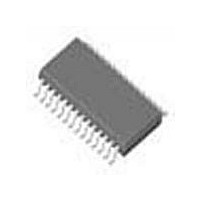LM4817MH National Semiconductor, LM4817MH Datasheet - Page 15

LM4817MH
Manufacturer Part Number
LM4817MH
Description
Manufacturer
National Semiconductor
Datasheet
1.LM4817MH.pdf
(21 pages)
Specifications of LM4817MH
Operational Class
Class-AB
Audio Amplifier Output Configuration
2-Channel Stereo
Output Power (typ)
1.1x2@8OhmW
Audio Amplifier Function
Speaker
Total Harmonic Distortion
0.13@8Ohm@1W%
Single Supply Voltage (typ)
5V
Dual Supply Voltage (typ)
Not RequiredV
Power Supply Requirement
Single
Rail/rail I/o Type
No
Power Supply Rejection Ratio
67dB
Single Supply Voltage (min)
3V
Single Supply Voltage (max)
5.5V
Dual Supply Voltage (min)
Not RequiredV
Dual Supply Voltage (max)
Not RequiredV
Operating Temp Range
-40C to 85C
Operating Temperature Classification
Industrial
Mounting
Surface Mount
Pin Count
28
Package Type
TSSOP EP
Lead Free Status / Rohs Status
Not Compliant
Available stocks
Company
Part Number
Manufacturer
Quantity
Price
Company:
Part Number:
LM4817MH
Manufacturer:
SKYWORKS
Quantity:
6 564
Part Number:
LM4817MH
Manufacturer:
NS/国半
Quantity:
20 000
Company:
Part Number:
LM4817MHX/NOPB
Manufacturer:
NS/TI
Quantity:
400
Application Information
AUDIO POWER AMPLIFIER DESIGN
Audio Amplifier Design: Driving 1W into an 8Ω Load
The following are the desired operational parameters:
The design begins by specifying the minimum supply voltage
necessary to obtain the specified output power. One way to
find the minimum supply voltage is to use the Output Power
vs Supply Voltage curve in the Typical Performance Char-
acteristics section. Another way, using Equation (4), is to
calculate the peak output voltage necessary to achieve the
desired output power for a given load impedance. To ac-
count for the amplifier’s dropout voltage, two additional volt-
ages, based on the Dropout Voltage vs Supply Voltage in the
Typical Performance Characteristics curves, must be
added to the result obtained by Equation (8). The result in
Equation (9).
The Output Power vs Supply Voltage graph for an 8Ω load
indicates a minimum supply voltage of 4.6V. This is easily
met by the commonly used 5V supply voltage. The additional
voltage creates the benefit of headroom, allowing the
LM4817 to produce peak output power in excess of 1W
without clipping or other audible distortion. The choice of
supply voltage must also not create a situation that violates
maximum power dissipation as explained above in the
Power Dissipation section.
After satisfying the LM4817’s power dissipation require-
ments, the minimum differential gain is found using Equation
(10).
Thus, a minimum gain of 2.83 allows the LM4817’s to reach
full output swing and maintain low noise and THD+N perfor-
mance. For this example, let A
The amplifier’s overall gain is set using the input (R
feedback (R
set at 20kΩ, the feedback resistor is found using Equation
(11).
The value of R
The last step in this design example is setting the amplifier’s
−3dB frequency bandwidth. To achieve the desired
pass band magnitude variation limit, the low frequency re-
sponse must extend to at least one−fifth the lower bandwidth
limit and the high frequency response must extend to at least
five times the upper bandwidth limit. The gain variation for
both response limits is 0.17dB, well within the
desired limit. The results are an
and an
Power Output:
Load Impedance:
Input Level:
Input Impedance:
Bandwidth:
V
DD
f
) resistors. With the desired input impedance
≥ (V
f
is 30kΩ.
OUTPEAK
f
L
= 100Hz/5 = 20Hz
R
f
/R
i
+ (V
= A
VD
VD
OD TOP
100Hz−20 kHz
= 3.
/2
+ V
(Continued)
OD BOT
))
±
0.25 dB
±
±
1W
1V
0.25dB
0.25dB
20kΩ
i
) and
RMS
RMS
(10)
(12)
8Ω
(11)
(8)
(9)
15
and C
bandpass frequency limit. Find the coupling capacitor’s
value using Equation (14).
the result is
Use a 0.39µF capacitor, the closest standard value.
The product of the desired high frequency cutoff (100kHz in
this example) and the differential gain, A
upper passband response limit. With A
100kHz, the closed-loop gain bandwidth product (GBWP) is
300kHz. This is less than the LM4817’s 3.5MHz GBWP. With
this margin, the amplifier can be used in designs that require
more differential gain while avoiding performance-lrestricting
bandwidth limitations.
LDO General Information
Figure 2 shows the LM4817’s LDO functional block diagram.
A 1.25V bandgap reference, an error amplifier and a PMOS
pass transistor perform voltage regulation while being sup-
ported by shutdown, fault, and the usual Temperature and
current protection circuitry
The regulator’s topology is the classic type with negative
feedback from the output to one of the inputs of the error
amplifier. Feedback resistors R
external to the IC, depending on whether it is the fixed
voltage version or the adjustable version. The negative feed-
back and high open loop gain of the error amplifier cause the
two inputs of the error amplifier to be virtually equal in
voltage. If the output voltage changes due to load changes,
the error amplifier provides the appropriate drive to the pass
transistor to maintain the error amplifier’s inputs as virtually
equal. In short, the error amplifier keeps the output voltage
constant in order to keep its inputs equal.
Output Voltage Setting
The output voltage is set according to the amount of nega-
tive feedback (Note that the pass transistor inverts the feed-
back signal). Figure 3 simplifies the LDO’s topology. This
As mentioned in the External Components section, R
i
create a highpass filter that sets the amplifier’s lower
FIGURE 2. LDO Functional Block Diagram
1/(2π*20kΩ*20Hz) = 0.398µF
F
H
= 20kHzx5 = 100kHz
1
and R
2
are either internal or
VD
VD
, determines the
= 3 and f
www.national.com
200781A0
(13)
(14)
(15)
H
=
i











